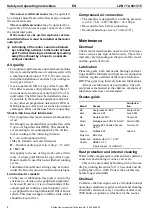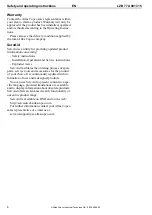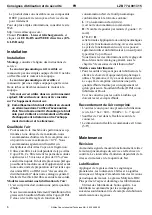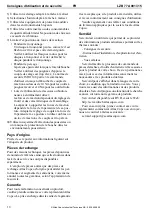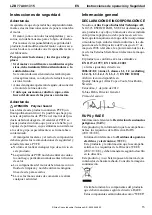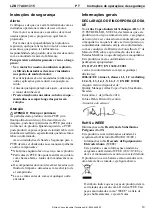
Overhaul should be carried out more frequently under
more rigorous operating conditions.
A
Clean the engine thoroughly.
Fit the engine and check that it rotates freely.
Pour two drops of oil into the air intake and
idle the engine for 5-10 seconds.
A
If the compressed air is very dry, the idle
speed for lubricant-free engines may de-
crease slightly after fairly long periods of
operation. This decrease may amount to 10-
15%.
Shaft load
The maximum shaft loads stated in our sales literat-
ure and in the diagram must not be exceeded in order
to prevent an excessive increase of the bearing tem-
perature.
Fr
(N)
800
600
1000
400
200
1200
1000
800
600
400
200
Fa
(N)
8002101
Fa
Fr
20 mm
Useful information
C
Log in to Atlas Copco www.atlascopco.com
You can find information concerning our products,
accessories, spare parts and published matters on our
website.
Ergonomic guidelines
1
) Take frequent breaks and change work positions
frequently.
2
) Adapt the workstation area to your needs and the
work task.
• Adjust for convenient reach range by determin-
ing where parts or tools should be located to
avoid static motion.
• Use workstation equipment such as tables and
chairs appropriate for the work task.
3
) Avoid work positions above shoulder level or with
static holding during assembly operations.
• When working above shoulder level, reduce
the load on the static muscles by reducing the
weight of the tool, using for example torque
arms, hose reels or weight balancers. You can
also reduce the load on the static muscles by
holding the tool close to the body.
• Make sure to take frequent breaks.
• Avoid extreme arm or wrist postures, particu-
larly for operations requiring a degree of force.
4
) Adjust for convenient field of vision by minimiz-
ing movement of the eyes and head during the
work task.
5
) Use the appropriate lighting for the work task.
6
) Select the appropriate tool for the work task.
7
) Use ear protection equipment in noisy environ-
ments.
8
) Use high-quality inserted tools or consumables to
minimize exposure to excessive levels of vibra-
tions.
9
) Minimize exposure to reaction forces.
• When cutting:
A cut-off wheel can get stuck if the wheel is
either bent or if it is not guided properly. Make
sure to use correct flanges for cut-off wheels
and avoid bending the wheel during cut-off
operation.
• When drilling:
The drill might stall when the drill bit breaks
through. Makes sure you use support handles
if the stall torque is too high. The safety stand-
ard ISO11148 part 3 recommends to use
something to absorb the reaction torque above
10 Nm for pistol grip tools and 4 Nm for
straight tools.
• When using direct driven screw or nutrunners:
Reaction forces depend on tool setting and joint
characteristics. The ability to bear reaction
forces depends on the operator’s strength and
posture. Adapt the torque setting to the operat-
or's strength and posture and use a torque arm
or reaction bar if the torque is too high.
10
) Use dust extraction system or mouth protection
mask in dusty environments.
Country of origin
Please refer to the information on the product label.
Spare parts
Parts without ordering number are not delivered
separately for technical reasons.
The use of other than genuine Atlas Copco replace-
ment parts may result in decreased tool performance
and increased maintenance and may, at the company
option, invalidate all warranties.
5
© Atlas Copco Industrial Technique AB - 9836 4468 00
Safety and operating instructions
EN
LZB 77 A0017-15




